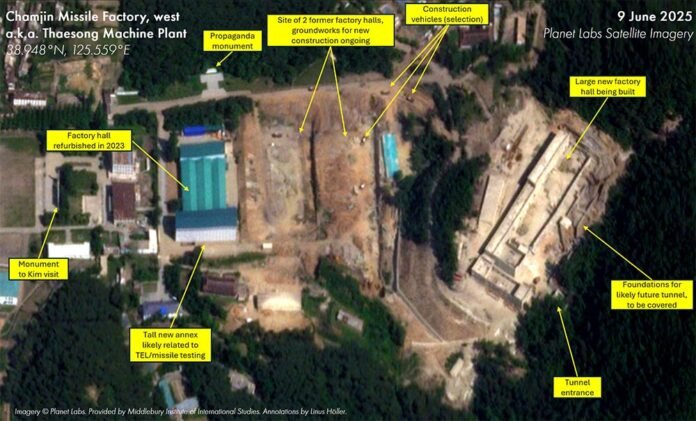The Hague: Construction at a North Korean missile factory could portend an upgrade to the country’s rocketry capabilities, according to satellite imagery and expert analysis. The building activities, which began last year at the Chamjin missile factory, 20 driving minutes southwest of Pyongyang, involve a mysterious annex to a factory building that has left outside observers puzzled.
Named the Thaesong machine plant by North Korean state media, the Chamjin missile factory dates back to at least the 1960s, declassified US Keyhole satellite imagery shows. The complex is nestled in a hard-to-access valley between three mountain peaks, secured by checkpoints on the entry roads, and defended by anti-aircraft nests. Wedged in the valley are two factory sites, some residential areas, a rocket engine test stand, and countless tunnel entrances into the sides of the abutting mountains.
At least two generations of the ruling Kim dynasty have visited the missile factory, images released by North Korean state media and independently geolocated reveal, which underscores its importance to the leadership.
Satellite images show that the western industrial area where the construction is currently underway has remained largely untouched for decades. Some of the factory halls were clearly dilapidated, with gaping holes in their roofs. In November 2023, the largest factory hall – the one now hosting the mysterious annex – received a makeover, including a new roof. Then, in July 2024, large-scale construction began across the facility. Three industrial halls and a series of smaller buildings closer to the tunnel entrances were razed to the ground, foundations were laid for new, larger factory halls, and significant earth-moving work got underway. Simultaneously, the previously reroofed factory hall received its annex.
A separate area of the same complex down the road to the east is known to be involved in the production of liquid-fueled missiles, with state media publishing images of leader Kim Jong-Un inspecting rockets and key components for the engines that appear to have been manufactured there.
A Burmese delegation visited the Chamjin complex in 2008 and reported that it was producing SCUD ground-to-ground missiles. A photo of such a missile that the delegation took appears to have been taken in the eastern section of the facility. Memoirs of an Iranian missile commander similarly include reference to a missile factory “on the road to Nampo,” the port city located to the southwest of Pyongyang.





